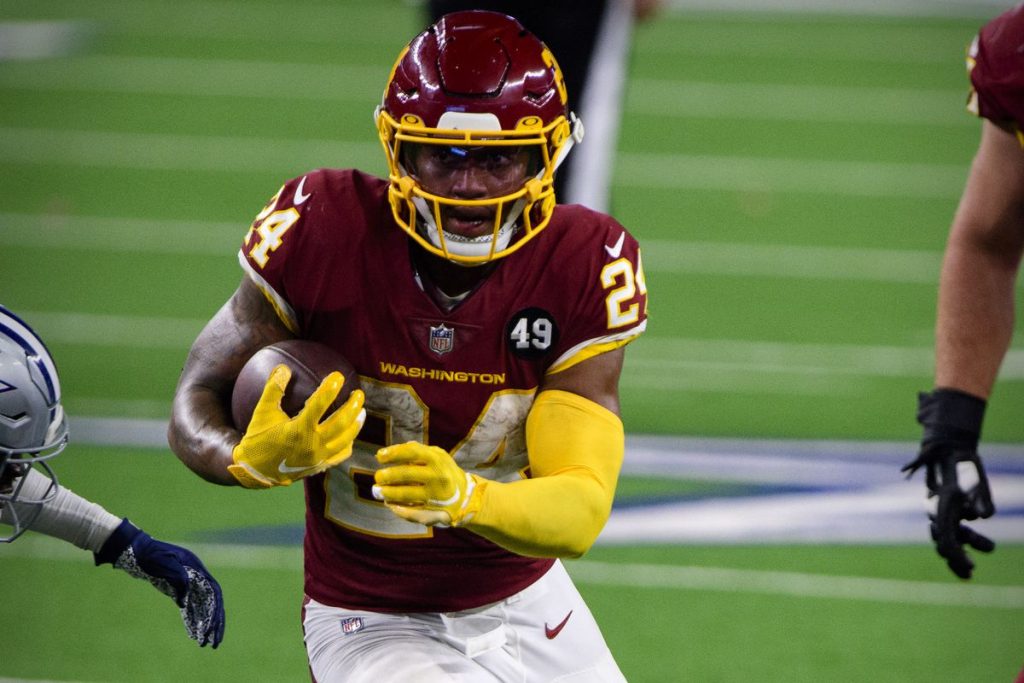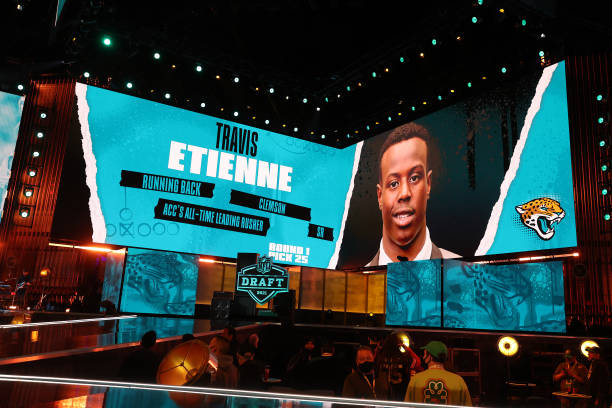Every year like clockwork, we are trying to find which rookies will be the steal of our drafts. Who is worth the risk relative to the consensus Average Draft Position (ADP)? Millions of opinions and experts are floating around, so how can we gain an edge?

This is what the Fantasy Z-Score aims to solve. This is the same model that found Antonio Gibson as an absolute steal last year and warned to be wary of reaching on guys like Zack Moss. Looking at all the stats and most predictive metrics that have translated to successful running backs creates a final projected three-year PPG outlook for all rookie running backs selected in the first four rounds of the NFL draft.
For simplicity, each of the major categories is broken down by grade. Each prospect is given a letter grade ranging from A+ to F on topics like “Draft Capital,” “College Production Adjusted For Competition,” “Athleticism Score,” and more. The final Z-score projection incorporates every category with varying weights pertaining to how strong the correlation to PPG is. Still, you are, of course, free to weigh them however you please. Just know that a holistic view of a prospect’s profile is very often the best, and the model’s history showcases that.
Method behind the Madness
This model is always evolving. Some years I’ll discover metrics that are better than what I have used before, and some years they’ll remain the same as they continue to perform well. This part may feel a bit long for some, so feel free to skip to the 2021 RB Rankings down the article if the process doesn’t interest you.
While no one stat is perfect, the combination of all gives us the best analytical chance at finding successful players. The following five categories were inspired by a combination of myself and some leading minds in the fantasy industry. Together they make up a player’s Z-score.
- Draft Capital
- By pick placement
- Lack of Backfield Fantasy Competition (Landing Spot)
- How many PPG are being scored by existing team RBs?
- Measures short-term opportunity to an extent
- Weaker competition translates into more touches for incoming rookies
- Athleticism Score
- Harvard Combine Metric (uses all available combine results)
- College ability as a dual-threat in rushing and receiving
- Broken Tackle Percentage
Developed a new score for Athleticism for Rookie RBs…. turns out that its starting rival Draft Capital 👀
— David Zäch (@DavidZach16) March 5, 2020
R^2:
Draft Capital – 0.34
Athleticism Score – 0.33 😃
This score is made using 3 categories:
– Harvard Combine Metric
– Broken Tackle %
– Weighted Rush/Rec Role
(1/2) pic.twitter.com/2l0yEM6n78
- NFL.com grade by Lance Zierlein
- Zierlein’s grades have historically predictive of future RB production
- Essentially the “Film Grade” of this model
[Thread] Ever wonder how PFF grades stack up versus https://t.co/fNcizuaTrs in predicting PPR PPG?
— Michael (@MiKeMeUpP) August 11, 2020
After diving into the data with @DavidZach16 for RBs and WRs drafted in rounds 1-4 from the last 4 years, one thing is clear:https://t.co/fNcizuaTrs > PFF Ranks >>> PFF Grades pic.twitter.com/MSJuCy73Km
- College Production Adjusted For Competition – Final Season
- Fantasy Points Per Game
- Team SRS (Simple Rating System)
- Team SOS (Strength Of Schedule)
- Receiving Yards Per Game
Each final letter grade is representative of what echelon of PPG that player falls into. (E.g., a 95% or better Athleticism Score as an A+). Please follow the Twitter links above for more detailed explanations of each category.
Draft Capital and Playing Time
Breaking down each category, we can understand their usefulness. Draft capital is self-explanatory. The higher the selection, the better the player likely is and the more investment from the team to ensure they succeed. Next is the lack of fantasy competition – aka immediate opportunity available. It can show us who has an immediate chance for success in their rookie year and early in their career. A team without a clear-cut leader is more likely to give the opportunity to their brand new rookie.
Athletic Scoring
Athleticism Score is what I defined as football athleticism as it relates to fantasy production. This consists of the Harvard Combine Metric, broken tackle percentage (courtesy of Sports Info Solutions), and their ability to work in both the rushing and receiving game in college as a dual threat. All of these correlate strongly to fantasy and, as a whole, is toe-to-toe with draft capital for relevance.
Grading
NFL.com grades by Lance Zierlein is a film breakdown of each running back’s talent according to one of the best film and draft analysts in the business. Similar to other major metrics, it has held up to draft capital as equally predictive of success. This is a major testament to the level of prestige Zierlein has achieved and continues to reproduce in his career as a film guru.
Advanced Metrics
College Production Adjusted For Competition was an idea first brought to my attention and pioneered by Underdog analyst Hayden Winks to adjust production for how strong a team was and how strong the competition they faced was. I used a multiple linear regression model involving the four variables I found to carry the highest significance (low p-values) to fantasy which consisted of college FPPG, receiving yards per game, and SportsReference metrics SRS (Simple Rating System) and SOS (Strength of Schedule). You can find Hayden on Twitter @HaydenWinks for some great analytic threads on the incoming rookies and more.
What makes all of the aforementioned stats important enough to include? They all have correlated strongly to PPG over the last six years. Draft capital itself has a historical R-squared of 0.44 to three-year PPG in my database. The Fantasy Z-score sits at 0.59, a massive improvement.
Compare for yourself last year’s model against ADP at the time, and you’ll clearly see the advantage this process gives us with proven results. Now let’s see where the 2021 class stacks up.
2021 Dynasty RB Rankings and Predictions
This draft class is quite different from last year’s as the tiers are far more shallow. We have a near-elite back at the top and then pretty clear tier drops one after the other. On the bright side, the gap between each tier should help make our decisions easier.
Below you will find each player’s Fantasy Z-Score rating, a snapshot of their profile grades, and their current consensus FantasyPros ECR. A full summary of the 2021 class all in one chart is included here for your viewing pleasure:
1. Najee Harris (PIT)
Projected PPG: 17.3
Consensus Rookie ADP: RB1
Before the NFL draft, there was no better landing spot for immediate running back opportunity than the Pittsburgh Steelers. He will have virtually no competition for the lion’s share of snaps right out of the gate. The Steelers’ high-powered offense should allow for plenty of red zone looks for the sturdy 232-pound back.
What stands out most in Harris’ profile was his college production. Yes, he is a bit older than most rookies, but that shouldn’t negate leading one of the nation’s best collegiate programs on the ground. His average of 145 yards per game when you adjust for teammate and opponent competition (league-leading 40 combined SRS and SOS for Alabama) helps lead the way to a rare “A+” grade. Only three other backs achieved this grade in the past six years. They are Saquon Barkley, Dalvin Cook, and JK Dobbins.
The largest concern for the Steelers right now is the lack of a stout offensive line. Many linemen gurus actually rank them as dead last in the league. This is obviously concerning for our stud running back, but volume is king, and Harris will receive all he can handle.
*Tier Break*
2. JaVonte Williams (DEN)
Projected PPG: 14.5
Consensus Rookie ADP: RB3
Williams has a multitude of impressive marks in his grade. Still, none is greater than his absolutely absurd broken tackle rate of 47% – the highest I’ve ever seen in Sports Info Solutions’ database. It seems he has no problem bulldozing through and shedding would-be tacklers.
RB Javonte Williams had an absolutely stunning broken tackle rate of 47% his final year. That's the highest I've seen recorded.
— David Zäch (@DavidZach16) March 23, 2021
So as a defender, that means there was about a 50/50 chance your ass was on the grass on contact as he runs by or through you.
JWill might be good.
As noted in the prelude, I define athleticism as three-fold for a running back: combine metrics, breaking/evading tackles, and dualism of rushing and receiving. Greatness or failure in any one of these subcategories will affect an Athleticism grade. So while Williams had a very average combine, he is elite in breaking tackles and above average as a dual-threat in rushing and receiving, hence the “A” grade.
Williams also lands in a perfect spot with the Denver Broncos. The aging Melvin Gordon is slowly fading, and Phillip Lindsay got sent out of town. While I still envision this being a rather hefty timeshare to start, Williams should be able to take over the reins in 2022 and beyond.
3. Travis Etienne (JAX)
Projected PPG: 14.4
Consensus Rookie ADP: RB2
Etienne has perhaps the best all-around profile of any of the big three running backs and comes away heads and shoulders above the rest in Zierlein’s film grade as his best in class.
The issue lies in the immediate hurdle to usage, with James Robinson already being rostered and Carlos Hyde added in the offseason. Robinson had a remarkable performance last year, and it is quite rare if his usage would plummet to next to nothing this year. The new coaching staff clearly has eyes for Etienne. Coach Meyer called him a “third-down back” with upside for more usage. Many in the community were perplexed by his being drafted here, and it downgrades both Robinson and Etienne in my 2021 projections.

If you believe in talent rising above the situation, Macho Man Randy Savage says it best: The cream rises to the top!
*Tier Break*
4. Rhamondre Stevenson (NE)
Projected PPG: 12.6
Consensus Rookie ADP: RB6
Stevenson slides into my RB4 slot due to some outstanding marks for a man who weighed in at 230 pounds on his pro day. He is only behind Etienne and Gainwell for the most receiving yards per game. Stevenson measured second-best in both broken tackle rate and athleticism grade of the class. So he is big, can catch, break tackles, and has good agility. This is the kind of late-round flier worth taking a chance on.
Round 3 or earlier RBs that have weighed in at 220+ and had 30+ receiving yards per game their final college season past 6 years:
— David Zäch (@DavidZach16) April 15, 2021
🔹Saquon Barkley
🔹David Johnson
🔹Joe Mixon
🔹Antonio Gibson
'21 class:
🔹Najee Harris 👀
🔹Rhamondre Stevenson? 👀👀
While Coach Bill is notorious for not giving a lot of work to his rookie running backs, keeping our eyes focused on the future paints a brighter picture. They have foregone Michel’s fifth year option, and signed 29 year old James White to a single year contract. By this time next year, it will be Damien Harris and Stevenson running this backfield. More importantly, Mac Jones will likely take over and neutralize Cam Newton’s touchdown vulturing.
The best part? He requires nearly no investment, routinely going in the third round of rookie drafts. Low cost mitigates risk, and the higher upside makes it an easy decision.
5. Trey Sermon (SF)
Projected PPG: 11.0
Consensus Rookie ADP: RB4
Lots of folks loved this landing spot, but the competition of Raheem Mostert and Jeff Wilson creates more near-term concern than most realize. However, the high attractiveness of Shanahan’s running scheme remains. But will this backfield ever leave a committee approach?
Sermon recorded the best weight-adjusted 3-cone time of the class, had good production in college – except for a slight lack of receiving work – and came in as Zierlein’s fourth-best grade for a back that was drafted on the first two days.
What’s more, the 49ers traded up in the draft to select him. This is another indicator of their desire to use him. While this is a crowded backfield, for now, Sermon could look to secure more opportunities next year – unless Mostert or Wilson get sent elsewhere.
6. Michael Carter (NYJ)
Projected PPG: 11.0
Consensus Rookie ADP: RB5
Many film analysts will argue that his film tells far more than the analytics, and let’s hope they are right for his sake. His college production was mediocre. He came in with an average athleticism score and received a below-average grade from NFL.com.
But now we get to the best part, landing on the Jets. New York was my second-best possible landing spot for a rookie back and should be thrust into an immediate starting role. However, buyer beware, as I still expect the Jets to land one of the bigger name free agent backs left remaining on the market.
The Final Word
The remaining backs can be found in the overall chart listed above. They are all a solid tier below this top-six, and their projections can give you an idea of what to expect.
I hope this breakdown was helpful for you to find the stats that matter most when researching your rookie running backs for the upcoming season. Stay tuned next week where I dive into wide receivers with a similar process.
Thanks for reading, and stay golden! If you like what you learned, follow me @DavidZach16 for more interesting stats and tidbits throughout the year.
Make sure you subscribe to the #NerdHerd, where you get exclusive content, dynasty/rookie/devy rankings, buy/sell tool, and a bonus podcast too. Dynasty Nerds also recently launched the #DynastyGM tool, which is a complete game-changer in the fantasy industry. Click here for a free trial. We truly are your one-stop shop for all your fantasy football needs!








